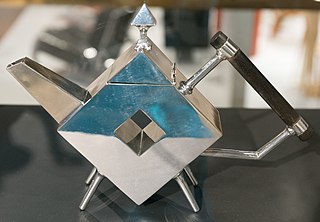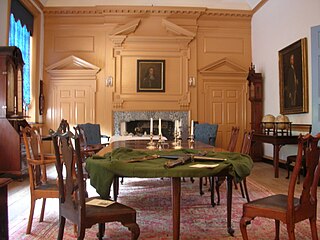
Furniture refers to movable objects intended to support various human activities such as seating, eating (tables), storing items, eating and/or working with an item, and sleeping. Furniture is also used to hold objects at a convenient height for work, or to store things. Furniture can be a product of design and can be considered a form of decorative art. In addition to furniture's functional role, it can serve a symbolic or religious purpose. It can be made from a vast multitude of materials, including metal, plastic, and wood. Furniture can be made using a variety of woodworking joints which often reflects the local culture.

Bright Future is a 2003 Japanese drama film written and directed by Kiyoshi Kurosawa, starring Tadanobu Asano, Joe Odagiri and Tatsuya Fuji. It was entered into the 2003 Cannes Film Festival.
The putting-out system is a means of subcontracting work. Historically, it was also known as the workshop system and the domestic system. In putting-out, work is contracted by a central agent to subcontractors who complete the project via remote work. It was used in the English and American textile industries, in shoemaking, lock-making trades, and making parts for small firearms from the Industrial Revolution until the mid-19th century. After the invention of the sewing machine in 1846, the system lingered on for the making of ready-made men's clothing.

In Western architecture, a living room, also called a lounge room, lounge, sitting room, or drawing room, is a room for relaxing and socializing in a residential house or apartment. Such a room is sometimes called a front room when it is near the main entrance at the front of the house. In large, formal homes, a sitting room is often a small private living area adjacent to a bedroom, such as the Queens' Sitting Room and the Lincoln Sitting Room of the White House.

Chinoiserie is the European interpretation and imitation of Chinese and other East Asian artistic traditions, especially in the decorative arts, garden design, architecture, literature, theatre, and music. The aesthetic of Chinoiserie has been expressed in different ways depending on the region. Its acknowledgement derives from the current of Orientalism, which studied Far East cultures from a historical, philological, anthropological, philosophical and religious point of view. First appearing in the 17th century, this trend was popularized in the 18th century due to the rise in trade with China and the rest of East Asia.

Japanning is a type of finish that originated as a European imitation of East Asian lacquerwork. It was first used on furniture, but was later much used on small items in metal. The word originated in the 17th century. American work, with the exception of the carriage and early automobile industries, is more often called toleware.

Wicker is the oldest furniture making method known to history, dating as far back as 5,000 years ago. It was first documented in ancient Egypt using pliable plant material, but in modern times it is made from any pliable, easily woven material. The word wicker or "wisker" is believed to be of Scandinavian origin: vika, which means "to fold" in Swedish, and vicker meaning willow. Wicker is traditionally made of material of plant origin, such as willow, rattan, reed, and bamboo, but synthetic fibers are now also used. Wicker is light yet sturdy, making it suitable for items that will be moved often like porch and patio furniture. Rushwork and wickerwork are terms used in England. A typical braiding pattern is called Wiener Geflecht, Viennese Braiding, as it was invented in 18th century Vienna and later most prominently used with the Thonet coffeehouse chair.

Christopher Dresser was a British designer and design theorist, now widely known as one of the first and most important independent designers. He was a pivotal figure in the Aesthetic Movement and a major contributor to the allied Anglo-Japanese or Modern Style, both of which originated in England and had long-lasting international influence.

The name zebrawood is used to describe several tree species and the wood derived from them. Zebrawood is characterized by a striped figure that is reminiscent of a zebra. The name originally applied to the wood of Astronium graveolens, a large tree native to Central America. In the 20th century, the most important source of zebrawood was Microberlinia brazzavillensis, also called zebrano, a tree native to Central Africa. Other sources include Brazilian Astronium fraxinifolium, African Brachystegia spiciformis, Pacific Guettarda speciosa, and Asian Pistacia integerrima.

American Craftsman is an American domestic architectural style, inspired by the Arts and Crafts movement, which included interior design, landscape design, applied arts, and decorative arts, beginning in the last years of the 19th century. Its immediate ancestors in American architecture are the Shingle style, which began the move away from Victorian ornamentation toward simpler forms; and the Prairie style of Frank Lloyd Wright. The name "Craftsman" was appropriated from furniture-maker Gustav Stickley, whose magazine The Craftsman was first published in 1901. The architectural style was most widely used in small-to-medium-sized Southern California single-family homes from about 1905, so that the smaller-scale Craftsman style became known alternatively as "California bungalow". The style remained popular into the 1930s, and has continued with revival and restoration projects through present times.
Virginia furniture is furniture that originates from the U.S. state of Virginia. Furniture was first produced in Virginia during the Colonial period and continued through the Industrial Revolution. Furniture production has decreased in recent times due to imported furniture, but Virginia is still home to a few large furniture companies.

Victorian decorative arts refers to the style of decorative arts during the Victorian era. Victorian design is widely viewed as having indulged in a grand excess of ornament. The Victorian era is known for its interpretation and eclectic revival of historic styles mixed with the introduction of Asian and Middle Eastern influences in furniture, fittings, and interior decoration. The Arts and Crafts movement, the aesthetic movement, Anglo-Japanese style, and Art Nouveau style have their beginnings in the late Victorian era and gothic period.

The Anglo-Japanese style developed in the United Kingdom through the Victorian period and early Edwardian period from approximately 1851 to the 1910s, when a new appreciation for Japanese design and culture influenced how designers and craftspeople made British art, especially the decorative arts and architecture of England, covering a vast array of art objects including ceramics, furniture and interior design. Important centres for design included London and Glasgow.

The Queen Anne style of furniture design developed before, during, and after the time of Queen Anne, who reigned from 1702 to 1714.

Queen Anne style architecture was one of a number of popular Victorian architectural styles that emerged in the United States during the period from roughly 1880 to 1910. Popular there during this time, it followed the Second Empire and Stick styles and preceded the Richardsonian Romanesque and Shingle styles. Sub-movements of Queen Anne include the Eastlake movement.
Irving Harper was an American industrial designer. While working for George Nelson Associates, Inc. on designs for Herman Miller furniture, Harper became one of the most prolific designers of the modernist style. Among his important designs is the Herman Miller company logo, and the company's Marshmallow sofa.
The Dilmaghani family, the oldest existing manufacturers of hand knotted carpets and oriental rugs, can be traced back to the 1850s Qajar dynasty, Persia. In an industry which largely produces untitled items often identifiable only by experts, the history and lineage of any name relating to specific types of rugs for so many decades is unusual. Through the 1960s, the Dilmaghani family was still designing, manufacturing and importing Persian carpets from Iran to the United States. Dilmaghani is seen as an important connection of 19th and 20th century Persian rug and carpet production in and around the cities of Tabriz and Kermān. Dilmaghani remains among the best known names of branded 19th, 20th and 21st century hand knotted carpets.

Kimbel & Cabus was a Victorian-era furniture and decorative arts firm based in New York City. The partnership was formed in 1862 between German-born cabinetmaker Anthony Kimbel and French-born cabinetmaker Joseph Cabus (1824–1894). The company was noted for its Modern Gothic and Anglo-Japanese style furniture, which it popularized at the 1876 Centennial Exposition.

Leather wallpaper is a type of wallpaper used in various styles for wall covering. It is often referred to as wrought leather. It is often gilded, painted and decorated. Leather was used to cover and decorate sections of walls in the houses of the rich, and some public buildings. Leather is pliable and could be decorated in various ways.

Daughters of the Samurai: A Journey from East to West and Back is a 2015 non-fiction book by Janice P. Nimura, primarily about the lives of Sutematsu Yamakawa, Shige Nagai, and Ume Tsuda. These three Japanese girls were sent to America as part of the Iwakura Mission in 1871, at the ages of 11, 10, and 6 respectively, to receive ten years of American education before returning to Japan in 1882. Nimura explores the personalities and emotional experiences of these girls as they grow into young women and attempt to reconcile conflicting national identities. The title of the book references Etsu Inagaki Sugimoto's autobiography, A Daughter of the Samurai. Unlike Etsu, who moved permanently to the United States in 1898, the earlier 'daughters of the samurai' in Nimura's book do not become Americans, but instead try to bring some part of America to Japan.
















